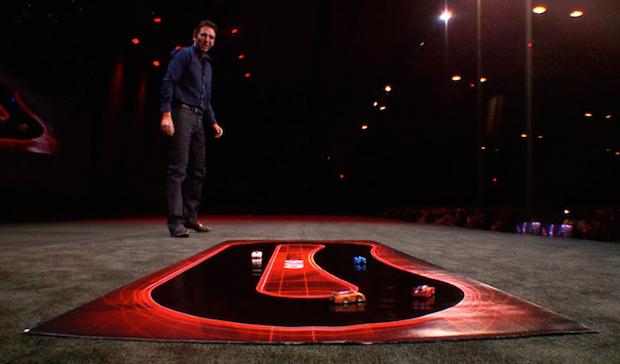- français
- English
News
The Internet of Things
March, 2010, McKinsey Quartely

But the predictable pathways of information are changing: the physical world itself is becoming a type of information system. In what’s called the Internet of Things, sensors and actuators embedded in physical objects—from roadways to pacemakers—are linked through wired and wireless networks. When objects can both sense the environment and communicate, they become tools for understanding complexity and responding to it swiftly.
The most demanding use of the Internet of Things involves the rapid, real-time sensing of unpredictable conditions and instantaneous responses guided by automated systems. Scientists in other industries are testing swarms of robots that maintain facilities or clean up toxic waste, and systems under study in the defense sector would coordinate the movements of groups of unmanned aircraft.
Anki at Apple's Worldwide Developers Conference (WWDC)
June 14, 2013, IEEE Spectrum

The company is called Anki. It's based in San Francisco, was founded by three Carnegie Mellon roboticists, and has raised an eye-popping $50 million from investors. It had been in stealth mode for years, but now, at Apple's keynote event, no less, it was ready to unveil its first product: Anki Drive is a racing game featuring toy-size robotic cars controlled by an iPhone app. It's not clear how the camera, which apparently faces downward, determines the car's position, but Sofman explains that the cars are "sensing down on the track, and there is information embedded that gives them knowledge about where they are."
Hybrid quadcopter RC car project is every kids dream
May 28, 2013, Geek.com
Off-Road Quad-copter..

Imagine taking your offroad RC car off of a huge ramp, and then flipping a switch to engage four propellers to keep the vehicle in flight. Or having an RC car that can make sharper turns because the propellers inside the wheels can lessen the load of any individual wheel. The light frame of the vehicle allows for flight, and the wheels are flexible and durable enough to land gracefully should you accidentally drop your vehicle out of the sky.
Raffaello D'Andrea: The astounding athletic power of quadcopters
June 2013, TED Global
D'Andrea gives another performance at TED, but what is he using for positioning?

In a robot lab at TEDGlobal, Raffaello D'Andrea demos his flying quadcopters: robots that think like athletes, solving physical problems with algorithms that help them learn. In a series of nifty demos, D'Andrea show drones that play catch, balance and make decisions together -- and watch out for an I-want-this-now demo of Kinect-controlled quads.
Beyond laser and vision: Alternative sensing techniques for robotic perception
July 11-12, 2012, University of Sydney

The ability to operate in challenging environments and conditions, e.g. limited visibility due to dust or fog, is of great importance for field robotics. In addition, increasingly complex and varied robotic applications require richer environment models. While perception based on traditional sensing (visual camera or laser range finder) has enabled important achievements in robotics, these have been restricted by the intrinsic limitations of the sensors. Alternative sensing modalities, which operate at various electromagnetic frequencies outside the visible spectrum, have allowed many new applications; examples include: automatic geological analysis using hyperspectral cameras, perception through smoke or at night with infrared imaging, road tracking in a dust storm using mm-wave radars. Furthermore, combining data from different sensing modalities can provide enhanced discrimination power and higher perception integrity.
Quadcopter Brain
February 15, 2013, Hack A Day
It’s an all-in-one control board for a Quadcopter.

At the center of the PCB is the jewel of the sensor array, a combination accelerometer and gyroscope. This location will help easy the trouble of designing PID algorithms to drive the four propellers. Also included in the sensor array is a magnetometer for navigation, and a barometric pressure sensor which can be used as an altimeter. There are four multipurpose connectors used to drive the motors and provide feedback to the boards.
Being Honest in Robot Videos: Motion Capture, Speedup Rates, and Teleoperation
July 2, 2012, Hizook
Busts UPenn for using Vicon
![]()
The UPenn quadrotors rely on $20k-$50k camera-based (Vicon) motion capture systems, which provide global pose estimation of each UAV at millimeter-accuracies at up to 1kHz (and often uses an external, centralized motion planning computer too)." That this crucial aspect of the videos does not register with intelligent people means that researchers are being disingenuous and violating their duty to the public --
- Ce wiki
- Cette page
